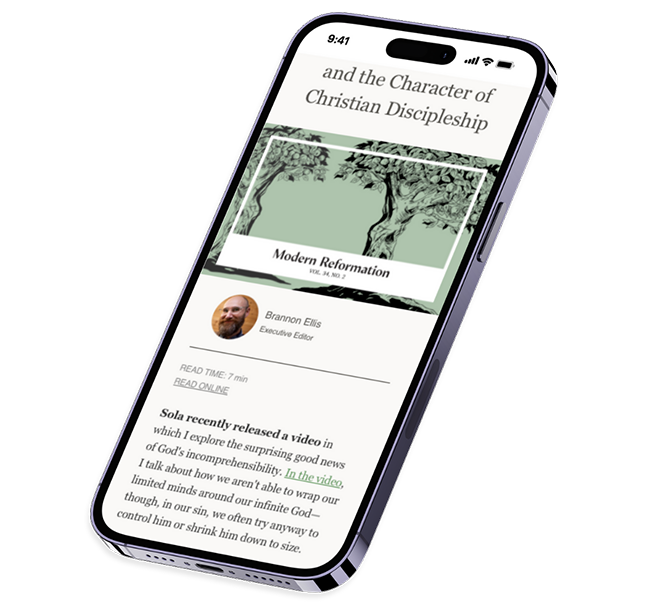On June 13, 1525, one of the most significant weddings in history took place. Admittedly, it was not as significant as that of Adam and Eve or Joseph and Mary, but it certainly outranked most royal weddings. The guest list was small, and the venue left much to be desired, having gone without necessary updates for quite some time. The groom was a fugitive from imperial justice. The bride too was unable to return to her home region for fear of arrest. They had little money between them.
Nevertheless, news of the marriage quickly became the hottest piece of gossip on the European continent, for this was the wedding of Martin Luther and Katharina von Bora, a former monk and a former nun. Though many members of the clergy had already married following Luther’s protest against the theology of Rome, it was the marriage of Luther—the most famous reformer, the chief target of Roman animosity—that caused the greatest sensation.
This was not merely a personal choice by one couple, however notorious. It was a calculated move to support the new understanding of marriage that Luther had been promoting: a purposely provocative act meant to enrage anyone who opposed the reformer’s understanding of law and gospel, chief among them the devil. But its greatest legacy came in setting the standard for clerical marriage that continues to this day within Protestantism.
While the Luther marriage was a theological and political act of great significance, it was also something far more intimate: the attempt of two people unaccustomed to the full duties of household life to live together in harmony despite little prior knowledge of the other’s foibles. There were plenty of reasons to doubt that it would work, but on the 500th anniversary of their union, here is the story of how Martin and Katharina survived the first year of a most unusual marriage.
An Abrupt Wedding
Even after Martin Luther was excommunicated by the Roman Catholic Church and released from his vows to the Order of St. Augustine, he saw no need to enter the married estate. The Holy Roman Emperor had sentenced him to death, and while Luther was protected within the bounds of the Electorate of Saxony, he had many reasons not to follow his fellow reformers into wedded bliss. His workload was beyond excessive, he had no property and few possessions, his income was not high, and he had passed the usual marrying age. Thus, he wrote to George Spalatin in November 1524 that, “the way I feel now, and have felt thus far, I will not marry. It is not that I do not feel my flesh or sex, since I am neither wood nor stone, but my mind is far removed from marriage, since I daily expect death and the punishment due to a heretic.”
Plenty of friends encouraged him to wed, to the point that his name was associated with two different females—Ave von Schönfeld and Ave Alemann—neither of whom he seems to have actively courted. This may be the reason he told Spalatin in April 1525,
“Yet if you want me to set an example, look, here you have the most powerful one, for I have had three wives simultaneously, and loved them so much that I have lost two who are taking other husbands; the third I can hardly keep with my left arm, and she, too, will probably soon be snatched away from me.”
The third woman was almost certainly Katharina von Bora, one of a group of nuns who escaped to Wittenberg after embracing Luther’s theology. Bora had experienced a broken engagement the previous year, bad news for a woman with no one to support her. A professor at the University of Wittenberg named Caspar Glatz was then put forward as a possibility, but she rejected him on account of some poor character traits. In a conversation recorded in the correspondence of Wittenberg pastor Johannes Bugenhagen, Katharina von Bora informed Dr. Nicholas von Amsdorf (a former professor at Wittenberg) that she was willing to marry either him or Dr. Luther.
Prominent Luther biographer Martin Brecht concludes that Luther was already thinking of marrying Katharina von Bora when he left on a trip to Thuringia on April 16, but the most definite proof of his intent does not come until May 4, when Luther wrote to his brother-in-law, “If I can manage it, before I die I will still marry my Katie to spite the devil, should I hear that the peasants continue. I trust they will not steal my courage and joy.” This was a reference to the violence of the German Peasants’ War, which was peaking at that time.
When Katharina von Bora learned of these plans is unknown, except that she must have been informed by June 13, the day of their marriage. Brecht notes that, “Contrary to the usual custom, the marriage (Kopulation) immediately followed the engagement.” Normally, couples in Saxony had a formal engagement and then a later public celebration with a religious ceremony, party, and bedding ritual. (Physical consummation was necessary to be legally married and thus had to be witnessed.) But Martin and Katharina had their engagement, a religious blessing, and the consummation all in one evening at the Black Cloister, a former dormitory for Augustinian friars in Wittenberg.
The sped-up timeline was almost certainly chosen to avoid gossip. Sadly for the Luthers, rumors persisted among those loyal to Rome that they had been living together in sin prior to the wedding, despite the lack of evidence.
Luther spent the days following their union writing to family and friends, inviting them to the public celebration of their nuptials. To Amsdorf, Luther wrote,
“Indeed, the rumor is true that I was suddenly married to Catherine; [I did this] to silence the evil mouths which are so used to complaining about me. For I still hope to live for a little while. In addition, I also did not want to reject this unique [opportunity to obey] my father’s wish for progeny, which he so often expressed. At the same time, I also wanted to confirm what I have taught by practicing it; for I find so many timid people in spite of such great light from the gospel. God has willed and brought about this step. For I feel neither passionate love nor burning for my spouse, but I cherish her.”
Among those not informed of the marriage beforehand was Luther’s colleague and fellow reformer, Philip Melanchthon, who was none too happy about it. “On June 13, Luther unexpectedly and without informing in advance any of his friends of what he was doing, married Bora,” Melanchthon complained to his friend Joachim Camerarius, writing in Greek to avoid others reading it. Fortunately, the two reformers settled any differences in time for the public celebration on June 27.
An Unexpected Visitor
Elector John of Saxony gifted the Black Cloister to the Luthers after their marriage, but any thoughts they may have had of time alone settling into married life were not to be. Luther’s former colleague Andreas Bodenstein von Karlstadt, who had moved in a more radical theological direction and turned into a major opponent, showed up at the Black Cloister with his young wife and two small children in tow, begging for refuge. As a result of the ongoing Peasants’ War, Karlstadt was sent on the run and found himself rejected by many of the peasants he aimed to champion. He spent some time wandering around in search of refuge but ultimately threw himself on the mercy of Martin Luther and Elector John. Luther was highly displeased, as he explained in a letter to John Briessmann.
“That miserable man found a secret refuge in my house. Now the whole world is not big enough for him; he is under such attack everywhere that he was finally forced to seek protection from his enemy. I treated that man in as friendly a way as I could, and helped him. But, as is usual with this type of spirit, he does not abandon his opinion, even when he is convicted [of error.]”
Martin and Katharina then hosted the Karlstadt family for several weeks in their home, an experience that must have been stressful for all involved. Historian Lyndal Roper notes that Karlstadt attempted to be cordial. “Addressing [Martin Luther] as ‘Gevatter,’ he begged forgiveness for ‘all I sinned against you, moved by the old Adam.’” He attempted to explain his actions and prove himself compliant. “Luther still did not trust him, however. While he lived under Luther’s roof, Karlstadt was compelled to write a full recantation of his view on the Last Supper, again printed at Wittenberg and once more prefaced by Luther.”
That summer, Katharina Luther also embarked on another process infamous for causing stress: home renovation. The condition of the Black Cloister had grown very poor as its inhabitants deserted both the monastic life and the building. As Rudolf and Marilynn Markwald note,
“Some household articles had disappeared. Many rooms lacked furniture. Even Martin Luther’s bed of straw had not been made for a whole year …. Kate’s first concern was the dilapidated walls of the former monastery. With the application of a great amount of lime, she whitewashed all of them. With the help of a maid, she then cleaned the rooms and put the garden in order.”
Given their lack of a courtship period, the Luthers could have benefitted from opportunities to learn more about each other in private. But Katharina received a baptism by fire into the life that would be hers for the next twenty years: always a full house, a massive workload, and the weight of the world on her shoulders. Yet, it was precisely the difficulty of their situation that may have brought Martin and Katharina closer together.
A Doctrinal Stand
Work does not stop for the newly married, and Martin Luther was no exception. In addition to his usual duties as professor at the University of Wittenberg and pastor at St. Mary’s Church, he was often called upon to address issues of the day with his pen. The previous autumn, the leading Roman Catholic intellectual of the day, Erasmus of Rotterdam, had sent him a book titled De Libero Arbitrio (On Free Will). In it, Erasmus took issue with Luther’s claim that free will “exists in name only,” arguing that human beings can achieve some degree of righteousness of their own accord.
Luther had always meant to respond, but the events of the Peasants’ War were among many factors that delayed him. Finally, over a year after receiving Erasmus’ book, Luther wrote De Servo Arbitrio (On Bound Will) and sent it to the printers, in which he argued that God is the sole active agent in salvation, and we have no free will to choose him. Luther finished the manuscript between November 11–18, 1525, and it was released in December 1525. On New Year’s Eve, he wrote to Michael Stifel, “I am sending you, my Michael, my rebuttal of Erasmus, which I completed as best I could in a short time and in a hurry.”
Martin Luther seems to have been in an unusually good frame of mind at the time he responded to Erasmus. Whatever he felt going into marriage with Katharina, he was decidedly enthusiastic about her by this point, joking with Spalatin shortly after the latter’s marriage that the two of them should bed their wives at the same time so they could be mutually happy. (Crucially, in different locations!) In all his letters from this time forward, he speaks of Katharina with great affection, passing on her greetings to his correspondents. Settling into married life may have helped him feel maximally free to respond to Erasmus. A particularly colorful description of the clash between these two scholars was provided by E. Gordon Rupp.
“To use the image of another day, it was a duel in which the two participants got up at crack of dawn, one armed with a rapier, the other with a blunderbuss, where shaking of fists and mutterings usurped the place of battle, and which ended with the two antagonists going their separate ways, undamaged but shaken, and with a frustrating sense of honor ruffled but unsatisfied.”
Although Luther’s response did nothing to change the minds of those loyal to Rome, it became a standard by which later Protestant understandings of predestination would be judged, impacting the development of Lutheranism, and perhaps even more the development of Reformed Christianity.
A Special Delivery
It did not take long for the Luthers’ time in bed to produce its natural result. By October 1525, Katharina was showing signs of pregnancy.” This as much as anything likely convinced Martin that they needed a different bed. He wrote to Gabriel Zwilling for assistance. “My Gabriel, I am sending the measurements for the length and width of the mattress as I would like to have it made. If there are any people [in your town] who know how to make one, please give the measurements to them. I shall pay whatever will have to be paid.”
Johannes “Hans” Luther was born on June 7, 1526, and baptized the same day by George Rörer. The boy was named in honor of Johannes Bugenhagen. It was a joyful end to an eventful year. The Luthers had endured war, polemics, undesired houseguests, a home remodel, and the difficulties of pregnancy, all while their marriage was under constant attack from critics near and far. Martin’s letter to Michael Stifel in late summer 1526 reveals a man who has found happiness in his personal life.
“God in his great goodness has blessed me with a healthy and vigorous son, John, a little Luther. Katie, my rib, sends her greetings and her appreciation that you have honored her with such a kind letter. She is well, by God’s grace, compliant, and in every way is obedient and obliging to me, more than I had ever dared to hope (thank God), so that I would not want to exchange my poverty for the riches of Croesus.”
The Luthers would go on to endure numerous trials throughout their marriage—financial difficulties, plague, depression, scurrilous pamphlets, the loss of two daughters—but already in that first year they were clinging tightly to one another and to God. That stood them in good stead in a rapidly changing world so often hostile to what they held dear.
Footnotes
“Letter 149 – To George Spalatin, Wittenberg, November 30, 1524,” in Luther’s Works (American edition), Volume 49 – Letters II, ed. and trans. Gottfried G. Krodel (Philadelphia: Fortress Press, 1972), 93.
Back“Letter 153 – To George Spalatin, [Wittenberg,] April 16, 1525,” Luther’s Works, 105n22.
Back“Letter 153 – To George Spalatin, [Wittenberg,] April 16, 1525,” Luther’s Works, 105.
BackBrecht, Martin. Martin Luther: Shaping and Defining the Reformation, 1521-1532, trans. James L. Schaaf (Minneapolis: Fortress Press, 1994), 196.
BackBrecht, 197.
Back“Letter 154 – To John Ruhel, Seeburg, May 4, 1525,” Luther’s Works, 111.
BackBrecht, 198.
Back“Letter 157 – To Nicholas von Amsdorf, [Wittenberg,] June 21, 1525,” Luther’s Works, 117.
Back“Letter 692 [version 1] – Melanchthon to Joachim Camerarius, Wittenberg, June 16, 1525,” in Luther’s Correspondence and Other Contemporary Letters, Volume II (1521–30), trans. and ed. Preserved Smith and Charles M. Jacobs (Philadelphia: The Lutheran Publication Society, 1918), 325.
Back“Letter 158 – To John Briessmann, Wittenberg, [after August 15,] 1525,” Luther’s Works,
Back
122–3.Roper, Lyndal. Martin Luther: Renegade and Prophet (New York: Random House, 2018), 258–9.
BackMarkwald, Rudolf K. and Marilynn Morris Markwald. Katharina von Bora: A Reformation Life (St. Louis, MO: Concordia Publishing House, 2002), 81.
BackTheses for the 1518 Heidelberg Disputation, Theological thesis 18. https://thebookofconcord.org/sources-and-context/heidelberg-disputation/
Back“Letter 162 – To Michael Stifel, Wittenberg, December 31, 1525,” Luther’s Works, 140 n3.
Back“Letter 162 – To Michael Stifel, Wittenberg, December 31, 1525,” Luther’s Works, 140.
Back“Letter 719 – Luther to George Spalatin, at Altenburg, Wittenburg, December 6, 1525,” Luther’s Correspondence, 356.
BackRupp, E. Gordon. “Introduction: The Erasmian Enigma” in Luther and Erasmus: Free Will and Salvation, ed. E. Gordon Rupp and Philip S. Watson, The Library of Christian Classics Ichthus Edition (Philadelphia: The Westminster Press, 1969), 1–2.
BackBrecht, 203.
Back“Letter 163 – To Gabriel Zwilling, Wittenberg, January 2, 1526,” Luther’s Works, 142.
Back“Letter 168 – To Michael Stifel, Wittenberg, August 11, 1526,” in Luther’s Works (American edition), Volume 49 – Letters II, ed. and trans. Gottfried G. Krodel (Philadelphia: Fortress Press, 1972), 154.
Back





